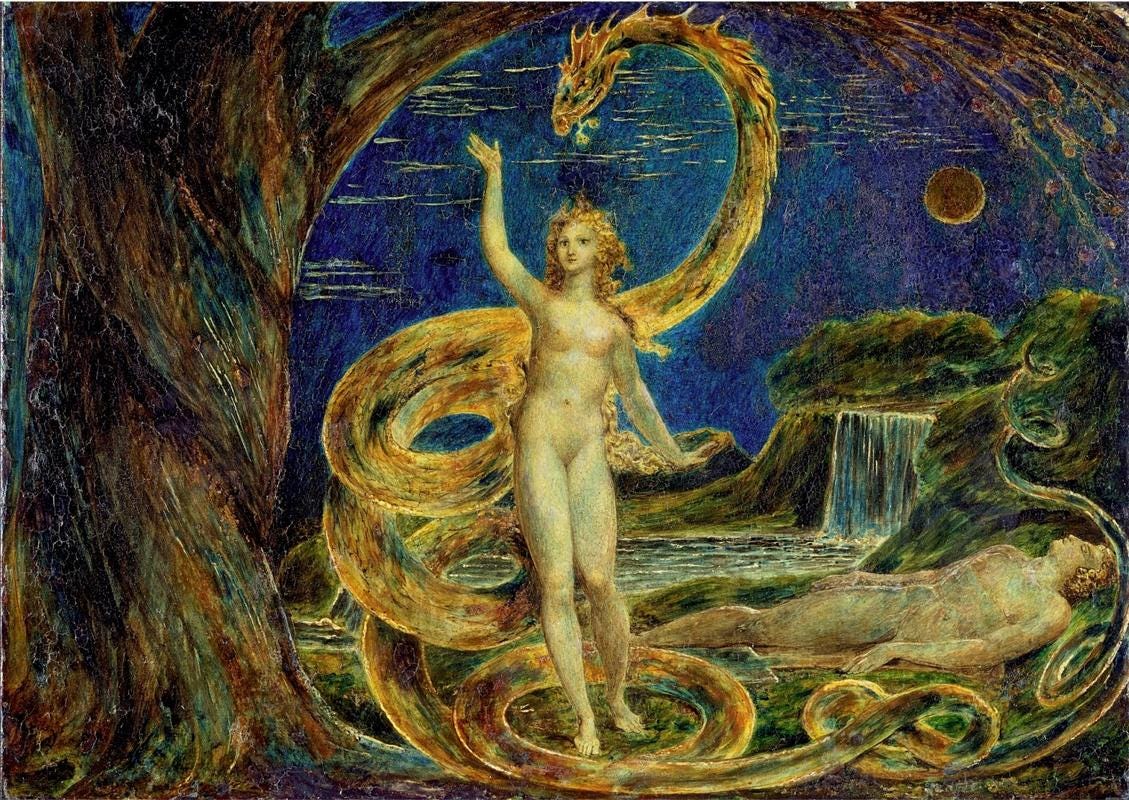Satanic Panic, But Make It Fashion
Sam Smith caused an Unholy Grammys furor. But there's so much more to fear. From men in grey suits to women in white -- could it be... Satan Chic?
Earlier this month at the Grammys, Sam Smith and Kim Petras gave a Hell-themed performance of their song “Unholy.” This triggered an unholy amount of backlash, including at least 18 FCC complaints for “glorifying Satan.” (Ticking off stuffy grownups was likely a desired result, as Smith’s onstage ensemble could best be described as the result of running into a Spirit Halloween and requesting “your most Glam Rock devil costume, please and thank you!”) Social media reactions rolled in, many with an “I saw Goody Petras dancing with the devil! I saw Sam Smith dancing with the devil!” vibe. Among those who took to Twitter was noted conservative pundit Ben Shapiro, who embarked upon a passionate reaction thread that led to this tweet:
Without doubt, this is the first time that Sam Smith, Ben Shapiro and John Milton have been brought together in any context. Once Paradise Lost worms its way into post-Grammy chatter, it’s clear that there are plenty of folks bound and determined to perform a pop-cultural exorcism. If we absolutely must have another Satanic Panic, then why limit the fashion references? Instead, cast a wider net! Since it seems unlikely that the Dark Lord would try to work his spell over the masses so overtly – after all, the Devil is famously most dangerous when he appears in disguise. We know that at times, he wears Prada. Fortunately, anyone with a library card and a good, healthy fear of evil can find plenty of other reference points for future fashion-related fire and brimstone.
Let’s start with the obvious. Ever since Genesis, snakes have been…a problem. From the slithering original-sin tempter to the chameleonic stranger bearing a “staff, which bore the likeness of a great black snake” in Nathaniel Hawthorne’s Young Goodman Browne, the Devil has long displayed a yen for serpentine style. If you spot a snakeskin bag or boots, it’s time to reach for the holy water. With all due respect to Signora Versace, this includes snake prints, too. (Given Hawthorne’s description, perhaps aesthetic-only walking sticks should also be cause for concern — apart from identifying the user as pretentious.)
Indeed, beastly signifiers abound. At first glance, Dante’s “Emperor of the kingdom dolorous” is far too ghastly to serve as fashion inspiration, what with his hulking stature, three monstrous faces and multiple sets of chiropteran wings. But beware – a clever evildoer might don a batwing sleeve to subtly indicate nefarious intention. (Frankly, embrace of this, or some other hideous ’80s silhouettes. often indicates a level of Aleister Crowley-like depravity anyway.) Dante’s multiple horned beasts should also make us suspect of anyone working some of Stephen Jones’s masterful haberdasheries.
Rounding out the runway bestiary of which to be wary – footwear. In Salmon Rushdie’s The Satanic Verses, when Saladin Chamcha undergoes his demonic metamorphosis, he finds himself with a “pair of shiny, cloven hoofs.” Rushdie references a tradition of devil-as-satyr that stretches back for centuries (possibly millennia, though the scholarly evidence conflicts). That means that the clomp-clomp of Margiela’s iconic Tabi boots indicates that something wicked this way comes (ditto a Marc Jacobs Kiki, and anything with too-hefty a platform).
A Faustian trio provides more fashion red flags. In Christopher Marlowe’s The Tragical History of Doctor Faustus, the good doctor is so horrified at Mephistopheles’s initial appearance that he commands, “Go, and return an old Franciscan friar.” Mephistopheles does as requested (he’s an obliging fellow). Monk-inspired ensembles should be an indicator that, at very least, one shouldn’t sign any contracts drawn up by the wearer (fare thee well, Rick Owens).
Goethe’s version of Mephistopheles ditches the drab, hermit look for something splashier. He appears as “a squire of high degree, in scarlet coat with gold trimming, A cloak in silken lustre swimming.” Red is already cause for concern, but just to be safe, add gilded trims and dreamy silk to the list of stylistic venality. Finally, while the devil of Thomas Mann’s Faust is an internal demon, Esmeralda, the prostitute who beguiles doomed composer Adrian Leverkühn, is very corporeal and wears “a Spanish jacket.” To err on the side of caution, tippets, boleros and any other shortened toppers should all ring the alarm bell that Old Scratch might be working through others.
The warning doesn’t end at Esmeralda’s duds. When Leverkühn, in the throes of a syphilitic fever dream, finally converses with his devil mano-a-fantasma, the demon claims Esmeralda as agent – how better to seduce an artiste into a 24-year contract than with an actual seduction? This devious, hallucinatory midnight visitor wears “stocking-knit shirt striped crosswise with sleeves too short…trousers that sit untowardly tight, and yellow, overworn shoes ne'er to be clean again.” Anyone affecting a faux-haute grunge posture should be greeted with a hearty, “get behind me, Satan.”
Usually, though, the Devil is a much nattier dresser. In Mikhail Bulgakov’s The Master and Margarita, the mysterious Woland first arrives decked out in “an expensive grey suit and imported shoes of a matching color.” Bad news for Tom Ford fans, or those hoping to emulate Lydia Tár austere power-woman chic. Woland’s accessories game is devilishly on point with a “grey beret cocked rakishly over one ear,” a walking stick topped with a poodle’s head (Hawthorne tried to warn us), and a pair of gloves. Woland and his entourage bring havoc to Moscow. (If you see a talking black cat named Behemoth – get thee to a nunnery.) Ultimately, Woland makes a strong case for his own necessity — “What would your good do if evil didn’t exist,” he asks, “and what would the earth look like if all the shadows disappeared?” — but he’s still very much an agent of chaos.
Finery in any form should be a cause of grave concern. Mark Twain famously quipped that “the clothes make the man.” They also make the Devil. In No. 44, The Mysterious Stranger, young Satan first materializes in an Austrian castle dressed rather shabbily. He soon ditches the humble attire for “Embroidered buskins, with red heels; pink silk tights; pale blue satin trunks; cloth of gold doublet; short satin cape of a blinding red; lace collar fit for a queen; the cunningest little blue velvet cap with a slender long feather standing up out of a fastening of clustered diamonds....” The road to Hell is paved with getups from a Real Housewives Reunion special.
Red, pink, blue, grey, gold, yellow, stripes – all out! Thanks to Jeremias Gotthelf, add another hue to the list. In The Black Spider, the Devil comes bearing woe as a “huntsman dressed in green from top to toe.” And if the pious are not already convinced that chapeaus should be a cause of great dismay, he finishes off the look with “a jaunty cap.”
Last, but certainly not least, beware the woman in white! One might think that surely, surely, the color associated with virgins pure as driven snow can’t be hiding anything darker underneath. Think again! CS Lewis’s Narnia White Queen is a descendant of Lilith, Adam’s first wife in some tellings, who not only got pushed aside for the younger Eve, but wound up with a nasty reputation as the mother of all demons, to boot. While Lilith’s evil nature is a topic of debate, the White Queen’s villainy is not. When it comes to judgment about who might be telegraphing allegiance to the Father of All Lies, it’s better safe (and saved!) than sorry. A woman “covered up to white fur in her throat” – she’s up to no good.
The Devil works in mysterious ways, and it appears that these ways now involve awards shows and runways. The biggest red-carpet of the year, the Oscars, will be upon us in three weeks. We must all keep our eyes peeled for any winking nods of fealty to Beelzebub and react accordingly. No possible evidence is too marginal; no breathless accusation of evildoing, too over the top. The proof is right there, from Marlowe to Bulgakov to Milton. Leave no sartorial stone unturned. Remember, it’s called a Satanic Panic, not a Satanic Measured Reaction.











Brilliant!